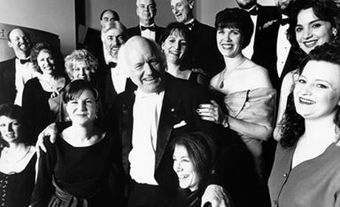Tape music includes any composition created with magnetic tape using prerecorded or electronic sounds that have been modified and assembled through techniques of mixing, splicing, speed changes, tape reversal, tape loops, tape echo and feedback, as well as electronic modifications. Electronic music refers to compositions produced with sounds generated electronically by oscillators and modified with filters, modulators or other equipment. Early work in electronic music occurred after WWII in Europe and North America, although many electric musical instruments (the Theremin, Ondes Martenot and Hammond organ) were invented earlier in the century.
Since the 1960s electronic music has become associated with commercially produced sound synthesizers, which are groupings of sound-generating and modifying units using the principle of voltage control to determine the sound parameters. Live electronics refers to musical performance with any combination of synthesizers and associated equipment, whereas studio composition involves mixing all materials onto tape for later playback. Digital technology is being integrated into all aspects of music and audio engineering, including digital recording on Compact Disc (CD), CD-ROM and Digital Audio Tape (DAT), as well as digital signal processing (DSP) and transmission via the Internet. The two-channel stereo format is standard, but multi-channel formats are also emerging.
Computer music is the application of digital technology to musical activity, such as computer-assisted composition, digital sound synthesis and, most recently, live performance with digital synthesizers using the MIDI (Musical Instrument Digital Interface) communications scheme. Computer music differs from other forms by using programs or software to control the process, and by representing sound as a series of numbers called samples. Some early computer-music systems in Canada were developed by Ken Pulfer of the National Research Council in 1969, Gustav Ciamaga and William Buxton at the University of Toronto, and Barry Truax at Simon Fraser University.
Since the mid-1980s, electroacoustic music production has increasingly utilized commercially produced hardware and software, including digital synthesizers and samplers controlled by the Musical Instrument Digital Interface (MIDI), communication protocol, and personal computers (PCs) equipped with sound cards and specialized software for assembling, processing and mixing sounds. Concert performance of elctroacoustic music may involve any of these devices interacting with live performers and visual elements, with the music projected into the space via multiple loudspeakers, a technique called sound diffusion. CD distribution of this type of music is generally on independent or private labels, Canadian examples being Empreintes Digitales in Montréal and Cambridge Street Records in Vancouver, who publish this music exclusively.
Electroacoustic techniques are used for both commercial and artistic types of music, the former usually associated with multi-track recording studios, and the latter with university and private studios as well as national radio networks in Europe. The first Canadian studios were established at the University of Toronto (1959) by Myron Schaeffer and at McGill University (1964) by Istvan Anhalt, and now are found in almost every university music faculty. Hugh Le Caine of the NRC was the most significant pioneer of electronic music in Canada through his design and construction of many specialized devices for composers and performers, including the first synthesizer, the Sackbut, in 1945.
Apart from universities, electroacoustic music is promoted in many Canadian centres by groups such as the Association pour la création et la recherche Électroacoustiques du Québec (ACREQ) in Montréal, the Music Gallery and Canadian Electronic Ensemble (CEE) in Toronto, Vancouver New Music and the Western Front Lodge in Vancouver, as well as by numerous composers, performers, the CBC and community radio stations. In 1986, a national association called the Canadian Electroacoustic Community (CEC) was formed to promote this music via festivals, a newsletter, recordings and the Internet. The International Computer Music Association (ICMA) has held three of its annual conferences in Canada, at Simon Fraser University in 1985, at McGill in 1991 and at the Banff Centre in 1995, and Canadian composers are frequent recipients of international awards. Today, electroacoustic music, despite the public's lack of familiarity with its artistic forms, is an important aspect of musical life.

 Share on Facebook
Share on Facebook Share on X
Share on X Share by Email
Share by Email Share on Google Classroom
Share on Google Classroom

